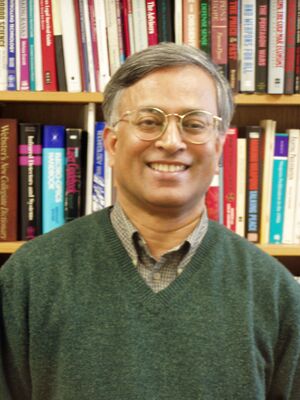Subrata Ghoshroy
(engineer, whistleblower) | |
|---|---|
 | |
| Alma mater | Northeastern University |
| Exposed | • SDI • Boeing • GAO |
Government Accountability Office whistleblower who exposed that his agency had "ignored evidence" of how a $26 billion Boeing "missile defence" system had "doctored data, skewed test results and made false statements". | |
Subrata Ghoshroy is an who as an investigator for the Government Accountability Office exposed scientific fraud among builders of a $26 billion "missile defence" system, including at TRW, a Boeing subcontractor. He became a whistleblower after the agency "ignored evidence that the two main contractors had doctored data, skewed test results and made false statements".[1]
Career
Subrata worked more than 20 years as an engineer and an engineering-manager in developing high-power and high-energy laser, electron beam, and pulse power technologies and managed sophisticated, interdisciplinary teams to develop advanced technology for DOD, DOE, and NASA.[2]
Subrata started working as a Congressional Fellow under the AAAS program. Later, he was a staff member of the House International Relations Committee and the House Armed Services Committee where he worked on issues of non-proliferation, arms control, South Asian security, ballistic missile defense, the Comprehensive Test Ban Treaty, nuclear weapons stockpile stewardship, laser weapons, chemical weapons demilitarization, and landmines. He was also responsible for monitoring and evaluating budget and policy matters related to Military Research and Development (RDT&E) using his expertise to carry out comprehensive evaluations of complex weapons systems that incorporate state-of-the-art technology.[2]
He has also been a Senior Defense Analyst at the Government Accountability Office for a number of years.[2]
Ghoshroy then was a Senior Fellow at the Belfer Center for Science and International Affairs.[2]
In 2005, he joined the Science, Technology and Global Security Working Group at the Massachusetts Institute of Technology, under professor Theodore Postol.[2]
He is a frequent contributor to the Bulletin of the Atomic Scientists.[3]
Boeing contract fraud
In 2006, the New York Times reported how:
A senior Congressional investigator has accused his agency of covering up a scientific fraud among builders of a $26 billion system meant to shield the nation from nuclear attack. The disputed weapon is the centerpiece of the Bush administration's antimissile plan, which is expected to cost more than $250 billion over the next two decades.
The investigator, Subrata Ghoshroy of the Government Accountability Office, led technical analyses of a prototype warhead for the antimissile weapon in an 18-month study.
The dispute over its reliability began a decade ago. Nira Schwartz, a senior engineer in 1995 and 1996 at the military contractor TRW, told her superiors that the company had falsified research findings meant to help kill vehicles differentiate incoming warheads from clouds of decoys.
Mr. Ghoshroy now says his agency ignored evidence that the two main contractors had doctored data, skewed test results and made false statements in a 2002 report that credited the contractors with revealing the warhead's failings to the government. Almost immediately, Mr. Ghoshroy recalled, the G.A.O. team found signs of a coverup -- for instance, disturbing charts buried at the back of an upbeat report.
The dispute is unusual. Rarely in the 85-year history of the G.A.O., an investigative arm of Congress with a reputation for nonpartisan accuracy, has a dissenter emerged publicly from its ranks.
On April 12, a G.A.O. manager wrote a draft summary of the team's findings. It strongly backed Dr. Schwartz, saying the contractors had "excluded some data and modified statistical techniques."
The summary added that failures of the kill vehicle during its test flight made most of the collected data unusable. It also questioned whether the test showed that "the Boeing sensor could distinguish a warhead from decoys."
Around this time, the G.A.O. team was directed to switch its focus from looking for fraud to searching for contractor admissions of failure. While it found written reports that disclosed some flight-test problems before Dr. Schwartz revealed them to federal investigators, it was unable to document them all.
Finally, the team learned of a meeting in late August 1997 at which contractor personnel had reportedly made complete oral disclosures. But no contractor or federal official could recall anything specific about this meeting -- no date, place, agenda or list of attendees.
Mr. Ghoshroy came to believe that the meeting had never happened, he said. Even so, the G.A.O. report incorporated its claims. The report also noted the explanations that the contractors gave for excluding some experimental data.
After the report was made public, Mr. Ghoshroy in private called for an independent investigation of its integrity. The G.A.O. conducted three internal inquiries, each absolving itself of any wrongdoing.[1]
A Document by Subrata Ghoshroy
| Title | Document type | Publication date | Subject(s) | Description |
|---|---|---|---|---|
| Document:Serious Questions about the Integrity of the UN Report on Syria | paper | 5 October 2013 | UN Syrian Chemical Weapons Attack | A detailed and scholarly study of the evidence presented in the UN special report on the use of Chemical weapons in Ghouta, Syria on 21 August 2013 and a similar report by 'Human Rights Watch' based largely on it. It is a damning indictment of the manner in which UN reports on sensitive matters and the entire HRW organisation are effectively suborned to Western geo-political purposes. |